Abstract
Stimulus-related fast oscillations in the γ-range (30–100 Hz) were clearly demonstrated with microelectrode recordings in visual cortex of awake monkeys, and they were also reported for recordings of human electroencephalograms (EEG). However, the presence of stimulus-related γ-modulation in human EEG has repeatedly been disputed. To clarify this dispute, we recorded the scalp EEG of man and monkey as well as intracortical field potentials (LFP) from monkey primary visual cortex (V1) during identical visual stimulation (large-field sinusoidal gratings, which proved to induce the largest γ-amplitudes in monkey V1 and V2). We found a strong stimulus-related increase of γ-oscillations in monkey LFP and EEG, but no modulation of γ-activity in human EEG. In contrast to previous results, γ-oscillations in the monkey were strongly phase-locked to stimulus onsets in early response periods (80–160 ms) and became gradually independent in later periods. Our negative result on γ-modulation in human subjects contradicts several published findings. We conclude from our results that visually evoked γ-modulations in humans EEG are not as accessible as in the monkey.
Similar content being viewed by others
Author information
Authors and Affiliations
Additional information
Received: 31 August 1998 / Accepted: 29 June 1999
Rights and permissions
About this article
Cite this article
Juergens, E., Guettler, A. & Eckhorn, R. Visual stimulation elicits locked and induced gamma oscillations in monkey intracortical- and EEG-potentials, but not in human EEG. Exp Brain Res 129, 247–259 (1999). https://doi.org/10.1007/s002210050895
Issue Date:
DOI: https://doi.org/10.1007/s002210050895




